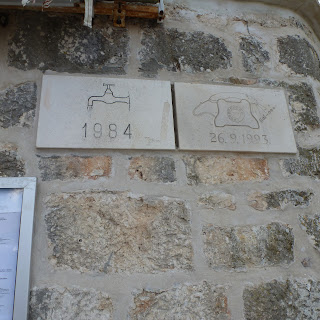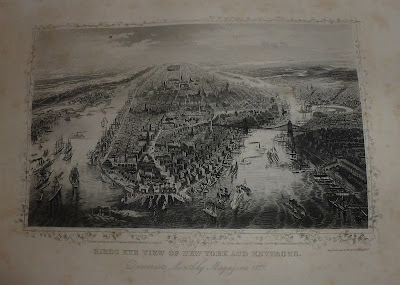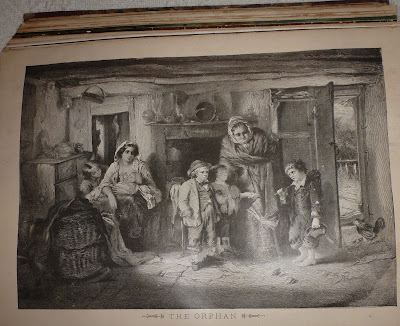 |
The name "Okljucna" means "around the key" here is the key
viewed from the road leading into Okljucna, Croatia.
|
His relatives welcomed us with "opened arms" and were wonderful. I will not name them because I do not publish the names of living people without their permission.

 We stayed and visited in Split with my mother-in-law's cousins. On the 3rd day we took a ferry to Vis where my husband's maternal grandparents were all born. The husband of one of his second cousins accompanied us to Vis and was an amazing guide to Okljucna, the semi-abandonded village where the Bozanic family lived and his grandparents migrated from. No one lives there now, but our "tour guide" could tell us who had lived in each house. I say semi-abandoned because there are members of the younger generation trying to restore some homes enough for weekend living --- including the Bozanic three-family.
We stayed and visited in Split with my mother-in-law's cousins. On the 3rd day we took a ferry to Vis where my husband's maternal grandparents were all born. The husband of one of his second cousins accompanied us to Vis and was an amazing guide to Okljucna, the semi-abandonded village where the Bozanic family lived and his grandparents migrated from. No one lives there now, but our "tour guide" could tell us who had lived in each house. I say semi-abandoned because there are members of the younger generation trying to restore some homes enough for weekend living --- including the Bozanic three-family.
 It is easy to see why folks have moved away from this scenic village -- no running water or wells -- just cisterns. Electricity has just recently come to the area and the "improved" roads are very rough. Now you can drive around, but the car scrapped bottom as we slowly went in, around and out 13 km. When my mother-in-law visited in 1991 she went in by donkey. The only street sign at the one crossroads, gives two towns, each "2h" [two hours] away by foot. The modern sign has replaced the old hand-lettered one my husband saw in his past trip. Any time they had to sell fish, for example, it was carried to Komiza or Vis on their backs or heads. They raised olives and grapes. Not an easy life.
It is easy to see why folks have moved away from this scenic village -- no running water or wells -- just cisterns. Electricity has just recently come to the area and the "improved" roads are very rough. Now you can drive around, but the car scrapped bottom as we slowly went in, around and out 13 km. When my mother-in-law visited in 1991 she went in by donkey. The only street sign at the one crossroads, gives two towns, each "2h" [two hours] away by foot. The modern sign has replaced the old hand-lettered one my husband saw in his past trip. Any time they had to sell fish, for example, it was carried to Komiza or Vis on their backs or heads. They raised olives and grapes. Not an easy life.We visited the tiny church. There are people in the village of Vis who care for it.
The inside is so small that there is only one small bench with a kneeler is on each side of the room along the walls. We noticed pictures of and a statue of St. Anthony, and immediately my husband and our guide started reciting the poem:
"St. Anthony, St. Anthony, please come around. Something's lost and can't be found" -- each in his own language.
I added: it's appropriately named since they have lost all of their congregation and some people definitely need to be found!
 |
| Road leading up to the church |
The surrounding buildings at the church are in a state of disrepair but till have some interesting things to see.
 |
| a beehive oven and rack to pull out the bread |
 |
| hoops for wine barrels |
 |
| a cistern -- bucket nearby and water within |
 |
| a sundial |
 |
| shoes left behind next to oven |
We spent time with relatives on Vis (the island) who now live in Komiza and Vis (the town) -- such hard working generous people -- even had a chance to share stories and my math books with one who teaches the same age students as I did (but then at the end of the school day joins his wife and father in their vineyard or olive grove).
We next took the ferry to Brac, this time our "tour guide" was another second cousin's husband. On our way to Splitska, were my husband's father was born, we stopped to visit relatives in Dracevica, a small town of 80 (down from 500). Again we were welcomed with open arms, a great meal and stories. The town around them is partially abandoned [St. Anthony are you listening?] but they have updated and expanded their house. They too are working multiple jobs, including a vineyard and running a general store. I was able to share my math books with a first year high school teacher of engineering.
They took me on a tour of the downtown which included these plaques.
This explains why my mother-in-law didn't know how to contact relatives on the island on my husband's first trip in the mid-1990s -- she hadn't gotten the news that telephones had come to the island of Brac. They also showed me the old horse-driven olive presses.
 |
| The "second" squeeze in cool press olive oil processing. Now the people take it elsewhere and it is done by machine without the horsepower in living color. |
 |
| The first squeeze of the olives. You can see how the horse could walk around driving the olive press. |
 |
| outhouse |
We walked around, chatted with neighbors, saw the closed neighborhood school, their abandoned stone outhouse and their still operating stone oven. My husband's family story is that on Vis, when they used the outhouse they only had flat stones to wipe themselves afterwards (I didn't ask whether that was true on Brac).
We could see the evidence of the where the wildfires burned the distant mountain and then came right up next to their home [firemen were pumping water on it to save it], three years ago. |
| oven |
We visited the Brac Museum in Skrip -- it is in a building that dates to Roman times and is next to our "tour guide's" ancestral family castle, also from Roman times. We saw the family store and the little church with a pine tree growing out of the roof in Nerezisca.
We were welcomed to Splitska by even more relatives -- who had stories to tell, a place to stay, and another tour guide who took us to Vidova Gora -- highest point on Brac at 778 m -- with a beautiful panorama view, including Vis on a clear day.
She took us to see the Vulic and Drpic houses where my father-in-law was born and lived until he immigrated to the US as a young boy.
I marveled at the irregular tessellation her husband designed, cut and laid on their porch.

 Both islands, Vis and Brac, are incredibly rocky. It is hard to imagine that anything can grow with stones everywhere: on the ground, stone walls, houses, roofs of houses, large piles. In fact, vineyards and olive groves usually are surrounded by stone walls and often have piles of stones between the trees.
Both islands, Vis and Brac, are incredibly rocky. It is hard to imagine that anything can grow with stones everywhere: on the ground, stone walls, houses, roofs of houses, large piles. In fact, vineyards and olive groves usually are surrounded by stone walls and often have piles of stones between the trees.
In Split and all the towns we visited on Vis and Brac, everywhere we were greeted joyfully with lots of hugs and kisses, stories were shared, we were well-fed, and then sent on our way with olive oil or wine.
 |
| Splitska from the road leading into town. |
I came home with a sense of what life was like for my husband's family in Croatia and a better understanding of why many people immigrated after the phylloxera pestilence wiped out the grape crops that my husband's family depended upon for their survival. I can only imagine what life was like for my own ancestors who came from other parts of Europe at an earlier time.
I will leave it to my husband to write up the genealogical findings, scan their photos, share their stories, and share the hundreds of pictures that I took.
The link to this blog post is http://genea-adventures.blogspot.com/2013/05/st-anthony-st-anthony-please-come.html
©2013 Erica Dakin Voolich













































